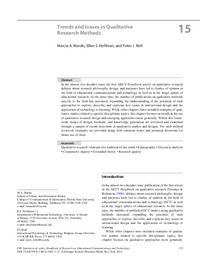Trends and Issues in Qualitative Research MethodsMarcia Mardis, Ellen S. Hoffman, Peter J. Rich
Zu finden in: Handbook of Research on Educational Communications and Technology (Seite 173 bis 193), 2014
|
 |
 Diese Seite wurde seit 10 Jahren inhaltlich nicht mehr aktualisiert.
Unter Umständen ist sie nicht mehr aktuell.
Diese Seite wurde seit 10 Jahren inhaltlich nicht mehr aktualisiert.
Unter Umständen ist sie nicht mehr aktuell.
 Zusammenfassungen
Zusammenfassungen
 In the almost two decades since the first AECT Handbook article on qualitative research debates about research philosophy, design, and purposes have led to clashes of opinion in the field of educational communications and technology as well as in the larger sphere of educational research. At the same time, the number of publications on qualitative methods specific to the field has increased, expanding the understanding of the potential of such approaches to explore, describe, and explicate key issues in instructional design and the application of technology to learning. While other chapters have included examples of qualitative studies related to specific disciplinary topics, this chapter focuses on trends in the use of qualitative research design and emerging approaches more generally. Within this framework, issues of design, methods, and knowledge generation are reviewed and examined through a sample of recent directions in qualitative studies and designs. For each method reviewed, examples are provided along with common issues and potential directions for future use of these.
In the almost two decades since the first AECT Handbook article on qualitative research debates about research philosophy, design, and purposes have led to clashes of opinion in the field of educational communications and technology as well as in the larger sphere of educational research. At the same time, the number of publications on qualitative methods specific to the field has increased, expanding the understanding of the potential of such approaches to explore, describe, and explicate key issues in instructional design and the application of technology to learning. While other chapters have included examples of qualitative studies related to specific disciplinary topics, this chapter focuses on trends in the use of qualitative research design and emerging approaches more generally. Within this framework, issues of design, methods, and knowledge generation are reviewed and examined through a sample of recent directions in qualitative studies and designs. For each method reviewed, examples are provided along with common issues and potential directions for future use of these. Dieses Kapitel erwähnt ...
Dieses Kapitel erwähnt ...
 Anderswo finden
Anderswo finden
 Volltext dieses Dokuments
Volltext dieses Dokuments
 |  Trends and Issues in Qualitative Research Methods: Artikel als Volltext bei Springerlink ( Trends and Issues in Qualitative Research Methods: Artikel als Volltext bei Springerlink ( : :  , 468 kByte; , 468 kByte;  : :  2020-11-28) 2020-11-28) |
 Anderswo suchen
Anderswo suchen 
 Beat und dieses Kapitel
Beat und dieses Kapitel
Beat hat Dieses Kapitel während seiner Zeit am Institut für Medien und Schule (IMS) ins Biblionetz aufgenommen. Er hat Dieses Kapitel einmalig erfasst und bisher nicht mehr bearbeitet. Beat besitzt kein physisches, aber ein digitales Exemplar. Eine digitale Version ist auf dem Internet verfügbar (s.o.). Aufgrund der wenigen Einträge im Biblionetz scheint er es nicht wirklich gelesen zu haben. Es gibt bisher auch nur wenige Objekte im Biblionetz, die dieses Werk zitieren.










 Lernen
Lernen
 Biblionetz-History
Biblionetz-History